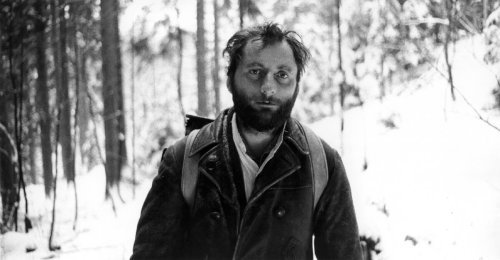 |
Vol 0, No 16
11 January 1999 |
|
|
 K I N O E Y E:
K I N O E Y E:Misty Melancholia in the Czech Mountains Ivan Vojnar's Cesta pustym lesem Andrew James Horton Judging by the Czech films that have made it to the London Film Festival in recent years, the selection panel consists entirely of members of the Prague tourist board. (Yes, yes... we all know you've got a beautiful capital - now show us you can still make decent films.) Amazingly, this year the festival actually managed to show a Czech film which didn't have a shot of Prague castle in it -Ivan Vojnar's debut feature Cesta pustym lesem (The Way through the Bleak Woods, 1997). What really makes this film significant, however, is not Vojnar's rejection of the great Czech metropolis in favour of the atmospheric Sumava forest, but rather that this is the most hauntingly original piece of Czech cinema for a good number years. The shifting narrative of Cesta pustym lesem centres on Dr Holoubek, a dentist who moves from Vienna to a remote corner of what was then a crumbling Austro-Hungarian empire. Why he makes the move is not quite clear. Once there, he becomes a disinterested observer of the frictions between the area's inhabitants. Gradually he becomes sucked into this world, chiefly on account of his involvement with a local girl Anna, whose liberal attitude to sleeping with lumberjacks leads the deeply conservative local population to conclude that she is responsible for a spate of thefts.
The arrival of the war is shown in fuzzy documentary film, a marked contrast to the hallucinogenic detail of Jaromir Kacer's photography. Indeed the whole film is a breath-taking example of cinematic visual style. Filmed evocatively in black and white and Cinemascope, the film's imagery is inspired by the qualities of old photographs. Hallucinogenic images Vojnar uses Kacer's hypnotic camera-work to create a film in which narrative is subordinate to emotional drive, to the sad, harsh, beauty suggested by the film's title. A story-line is definitely present but instead of being frog-marched forward by the demands of dense plotting, it floats effortlessly past the viewer as if it were being carried by the meltwater of a Sumava stream.
This more serious style of cinema also demands a change in acting style, reintroducing a sense of gravitas that is unusual in Czech film. This in particular stands out since the Czech Republic has traditionally been very strong on light comedies. Once, these comedies were done without descending to the level of farce - think of Milos Forman's Lasky jedne plavovlasky (Loves of a Blonde, 1965) - but more recently things have degenerated. Less sophisticated directors, even in relatively serious films, are increasingly taking comic short cuts on order to get in some cheap pantomime jokes. Nothing could be further from the truth in Cesta pustym lesem. Vojnar, of course, doesn't play for any laughs at all, but that in itself is not particularly interesting. More noteworthy is the fact that his characters are believable by dint of the fact that they are endowed with an intensity that, like the camerawork, is hyper-realistic rather than naturalistic. Eastern aesthetics This is Vojnar's first feature film, although at the age of 51 he can hardly be described as a "young director." Nor can he be called a newcomer to film, since for many years now he has made documentaries. Vojnar's first work of fiction is both exhilarating and studied and stands high above the mainstream of Czech cinema. Not all Czech film critics would agree with me however: Cinema called the film "unbalanced" and "flat" and gave it a measly 40% rating and Kinofil, in considering the film's apparent lack of content, compared it to (believe it or not) The Lost World and Men in Black. If I were forced to compare the film to another, though, I would look east not west. Vojnar's aesthetics are not in tune with either Hollywood or Western European cinema, but more with Russian cinematography -no wonder Czech critics hated the film. Poetics in Russian cinema has long reigned supreme. Since the early experimental days of Soviet film, a dominance of what the Russian Formalists called siuzhet (the plot, in the sense of the artistic rearrangement of events) over fabula (the story, in the sense of a series of events linked chronologically and causaly) has been recognised as a valid mode of expression and has been used by masters as diverse as Dovzhenko (actually a Ukrainian) and Tarkovsky. In particular, Cesta pustym lesem seems not too far removed from Aleksandr Sokurov's contemporaneous film Mat' i syn (Mother and Son, 1997), which caused a sensation in London last year. Critics, including cult guru of weirdness Nick Cave, unanimously raved about Mat' i syn. They found its moody photography, inspired by the mist-filled paintings of the German Romantic landscape artist Caspar David Friedrich, electrifying and praised the film's stars, ordinary people chosen by Sokurov for their presence rather than their acting capabilities. Cinema-goers were urged to see the film, even though it completely lacks what might be termed a linear strory-line. All of which sounds remarkably similar to Vojnar's film, apart from the adulation of the critics of course. I hesitate to mention Sokurov and Vojnar in the same sentence; since for a start, it is very rash to begin comparing auteurs to each other, and secondly Sokurov is a genius, whereas Vojnar is clearly just very gifted. He is certainly one to watch, though. Cesta pustym lesem gives me that nagging feeling that, whilst it is in every way a wonderful film, it comes from a director who has not yet made his masterwork. So far, London seems to have been slightly kinder to Vojnar than Prague. Already having had a flavour of this poetic style of cinema earlier in the year, Londoners flocked to see the UK premiere of Cesta pustym lesem. Let us hope that Vojnar is not disheartened by the lack of success in his homeland and continues to explore the outer reaches of cinematic narrative and image. Andrew James Horton, 11 January 1999 Further Surfing In Czech, there are the usual run of sites: reviews from Cinema, Kinofil, and Capitol and production credits from Czech Movie Heaven. Czech Movie Heaven also has a review up from Mlada Fronta Dnes. After their comparison of Cesta pustym lesem to Men in Black, Kinofil redeem themselves by mentioning Vojnar's film more favourably in an article on film extremism, among works by David Lynch, Peter Greenaway and David Cronenburg. The Febio festival site looks set to put up a whole series of profiles of Czech (and other) directors, Vojnar included. Two more websites of interest for Cesta are a review in the journal Respekt and detailed production notes (including good profiles of Vojnar and his cameraman Kacer) from Czech Television. For CER's special focus on Sokurov, including articles and a links page, click here
|
|
![]()
Copyright (c) 1999 - Central Europe Review and Internet servis, a.s.
All Rights
Reserved
 Anna repays Holoubek's kindness in the only way she knows, with her body - but not quite with her heart. Their frolics arouse the envy of a local lad, Teda, who has long since been an admirer of Anna. The conflict between the two men is resolved when World War I starts and the two men are called up, leaving Anna to look elsewhere for love.
Anna repays Holoubek's kindness in the only way she knows, with her body - but not quite with her heart. Their frolics arouse the envy of a local lad, Teda, who has long since been an admirer of Anna. The conflict between the two men is resolved when World War I starts and the two men are called up, leaving Anna to look elsewhere for love. There is absolutely no artificiality in the painting of this cinematic portrait, and the film makes a refreshing break from the long-held tradition that somehow everything in a film has to be an essential component in working towards its denouement. Vojnar's non-linear approach means that my little description of the story-line above, although technically accurate, conveys nothing of the film's real texture. Its richness lies in the story's fine individual brushstrokes rather than in any broad sweep of the story-line. In short, Vojnar evokes a story rather than narrates it.
There is absolutely no artificiality in the painting of this cinematic portrait, and the film makes a refreshing break from the long-held tradition that somehow everything in a film has to be an essential component in working towards its denouement. Vojnar's non-linear approach means that my little description of the story-line above, although technically accurate, conveys nothing of the film's real texture. Its richness lies in the story's fine individual brushstrokes rather than in any broad sweep of the story-line. In short, Vojnar evokes a story rather than narrates it.